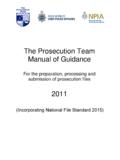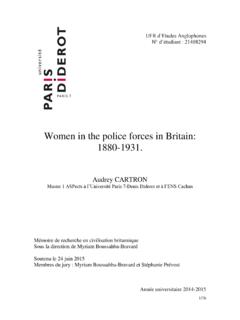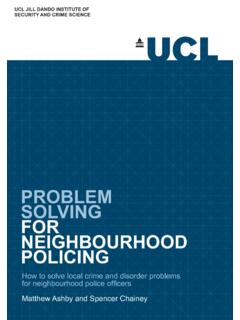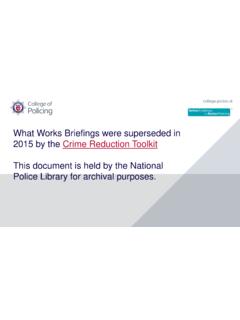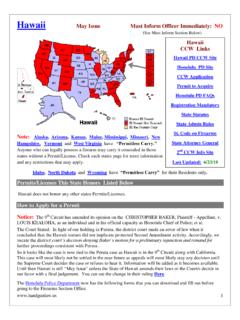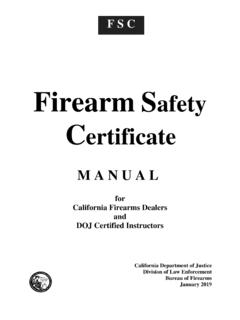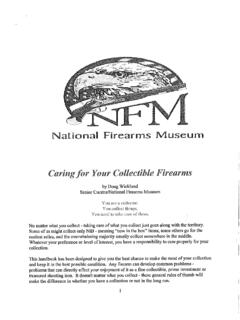Transcription of Code of Practice consultation draft 07 08 09
1 Not protectively marked Code of Practice on Police Firearms and Less Lethal Weapons consultation draft Laid before Parliament pursuant to sections 39 and 39A of the Police Act 1996 and section 10 of the Serious Organised Crime and Police Act 2005. Not protectively marked 1. Not protectively marked Contents 1 Introduction Purpose of the code Statutory basis of the code Weapons covered by this code Armed support to police operations 2 Scope and status of this code Law relating to the use of force Relationship of the code to other guidance 3 Licensing of training National Policing Improvement Agency licensing process 4 Basic requirements of this code Nominated firearms lead in each force Strategic firearms threat and risk assessment 5 Weapons, related equipment and tactics: development and approval Availability of approved weapons Issue of weapons to competent officers Development and approval of new less lethal weapons and operating procedures Weapons and ammunition under development or on trial 6 Training.
2 Standards and accreditation Selection, training and maintaining competence Standardisation of training to specified levels of competence Independent approval of training 7 Promulgation of learning and current best Practice Promulgation of current best Practice Immediate reporting of safety-critical information Not protectively marked 2. Not protectively marked Community impact 8 Post incident procedures Post incident investigation and welfare of staff Not protectively marked 3. Not protectively marked 1 Introduction Purpose of the code The purpose of this code is: To set out the responsibilities of the chief officer in relation to the police use of firearms and less lethal weapons;. To set out the procedures for the development and approval of new weapons, ammunition and operating procedures;. To set out the procedures for selection, training and accreditation of officers, and the licensing of training delivery;. To encourage the identification and promulgation of good Practice .
3 To specify the procedures to support post incident investigations, and post incident welfare of staff. This code relates to any officer authorised to deploy with firearms and less lethal weapons including Conducted Energy Devices (CEDs) and Attenuating Energy Projectiles (AEPs) and their delivery systems. Detailed guidance is provided in the ACPO Manual of Guidance on the Management, Command and Deployment of Armed Officers and the National Police Firearms Training Curriculum (NPFTC). Statutory basis of the code This code of Practice comes into effect on [date to be inserted] and replaces the code of Practice on Police Use of Firearms and Less Lethal Weapons dated December 3 2003. This code of Practice is issued under: Section 39 of the Police Act 1996, which permits the Secretary of State to issue codes of Practice relating to the discharge by police authorities of any of their functions;. Section 39A of the same Act (as inserted by section 2 of the Police Reform Act 2002) which permits the Secretary of State to issue codes of Practice for the purpose of promoting the efficiency and effectiveness of police forces in England and Wales relating to the discharge of functions by chief officers.
4 Section 10 of the Serious Organised Crime and Police Act 2005, which permits the Secretary of State to issue codes of Practice relating to the exercise by the Serious Organised Crime Agency (SOCA) of any of its functions. Under sections 6 and 37A of the Police Act 1996, chief officers and police authorities have a duty to have regard to this code of Practice when discharging a function to which this code relates. Under section 4 of the Serious Organised Crime and Police Act 2005, in exercising a function to which this code relates, SOCA must have regard to this code. This code must be followed unless there is a good reason not to do so, in which case the decision not to follow the code should be recorded in writing. Not protectively marked 4. Not protectively marked This code is issued to the chief officers and police authorities of police forces maintained for the police areas of England and Wales defined in section 1 of the Police Act 1996, and to SOCA. This code is available for adoption by other non-Home Office police forces in England and Wales, and by other jurisdictions within the United Kingdom.
5 In relation to SOCA, references in this code to chief officers should be read as references to SOCA. Weapons covered by this code This code applies to any firearm and less lethal weapon available for deployment within police forces, on the authority of a designated officer, in the circumstances described within the ACPO Manual of Guidance on the Management, Command and Deployment of Armed Officers. The range of equipment available to police forces includes conventional firearms, munitions and less lethal weapons which may not necessarily fall within the statutory definition of a firearm , but for which thresholds of competence in respect of their command, deployment and use will be required. This includes all conventional firearms, Conducted Energy Devices (CEDs) and Attenuating Energy Projectiles (AEPs) and their delivery systems. This code applies to all such weapons available to police forces now or in the future. An example of the type of weapon is given in the ACPO Manual of Guidance on the Management, Command and Deployment of Armed Officers (this is not a definitive list).
6 The chief officer is accountable for the choice of weapons, and this must be justified by the force's strategic firearms threat and risk assessment. The chief officer should determine the choice of weapons, and who they may be issued to, with reference to central guidance held by ACPO and Home Office/Home Office Scientific Development Branch (HOSDB). For further information see Strategic firearms threat and risk assessment This code does not apply to police equipment routinely issued to patrol officers for self defence purposes, for example incapacitant sprays and batons. Armed support to police operations The police service in England and Wales remains a predominantly unarmed service. Police officers may, however, have to deal with persons who may be in possession of a firearm ; persons who have immediate access to a firearm or other potentially lethal weapon; or other situations representing a threat to which a response requiring firearms and/or less lethal weapons is appropriate.
7 In such cases it may be necessary for officers to be armed for the protection of members of the public, or for their own safety. To meet all those needs, police forces maintain an Not protectively marked 5. Not protectively marked armed capability, and certain officers or groups of officers may need to be granted a standing authority for the carriage of firearms and less lethal weapons. In order to reduce the risk of death or serious injury, the equipment available to police forces must include less lethal weapons and munitions, as specified by the UN Basic Principles on Use of Force and Firearms by Law Enforcement Officials. 2. Scope and status of this code Law relating to the use of force The use of force by the police is governed by the general law of England and Wales, the relevant parts of which are referred to within the ACPO. Manual of Guidance on the Management, Command and Deployment of Armed Officers and the National Police Firearms Training Curriculum.
8 Police officers will only use force which is necessary, proportionate, reasonable and legal, and will respect and preserve human life. Relationship of the code to other guidance Chief officers must take account of the ACPO Manual of Guidance on the Management, Command and Deployment of Armed Officers when making arrangements for the authorisation, deployment and use of firearms and less lethal weapons. Chief officers must also take account of guidance issued by ACPO relating to public order and officer safety. 3. Licensing of training National Policing Improvement Agency licensing process Training in the police use of firearms and less lethal weapons must be licensed to comply with this code. The licensing process is managed by the National Policing Improvement Agency on behalf of the ACPO Working Group on Armed Policing, and monitored through a programme of inspection, self-inspection and reaccreditation. 4. Basic Requirements of this code Nominated firearms lead in each force For the purpose of maintaining standards within each force, chief officers should ensure that an officer of at least the rank of Assistant Chief Constable, or equivalent, is nominated to take the lead within the force in relation to the management, command and deployment of armed officers.
9 Strategic firearms threat and risk assessment Not protectively marked 6. Not protectively marked Chief officers are responsible for establishing the operational requirement for their police areas in order to determine a policy for the provision of police firearms and less lethal weapons, and the equipment, training and accreditation of Authorised Firearms Officers (AFOs), Tactical Advisors, Commanders and Post Incident Managers (PIMs). National minimum standards have been agreed by ACPO with regard to certain roles. Chief officers should assess the known and reasonably foreseeable threats and risks in their police areas which may be relevant to the use of police firearms and less lethal weapons. This should include the needs of cross- boundary collaboration and interoperability, the force's potential obligations under mutual aid arrangements and their responsibilities in respect of national commitments, regional and local plans. National best Practice and recommendations made by bodies such as HM Inspectorate of Constabulary, Independent Police Complaints Commission and the ACPO Working Group on Armed Policing should also be taken into account.
10 Each force's assessments should be regularly reviewed and updated, at least twice annually. Guidance on the strategic firearms threat and risk assessment is contained in Centrex (2006) Firearms Threat and Risk Assessment Guide. 5. Weapons, related equipment and tactics: development and approval Availability of approved weapons Chief officers, in consultation with their police authorities, will be accountable for the acquisition of firearms and less lethal weapons for use in their force areas, justified by the threat and risk assessment process referred to at section Issue of weapons to competent officers Firearms and less lethal weapons should be issued only to officers assessed as competent to use them in accordance with the training and assessment procedures at section 6 below. Development and approval of new less lethal weapons and operating procedures The continuing development of less lethal weapons, and their related operating procedures, will be centrally coordinated by the Home Office on behalf of the ACPO Working Group on Armed Policing.

